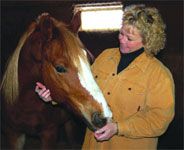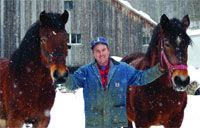Desperate search for rural DVMs
Colebrook, N.H. - Despite warnings describing the shortage of large-animal veterinarians as acute, new graduates continue to steer clear of what's arguably the profession's neediest segment.
COLEBROOK, N.H. — Despite warnings describing the shortage of large-animal veterinarians as acute, new graduates continue to steer clear of what's arguably the profession's neediest segment.

Wide-open field: Carol Couture fears for the health of her eight horses considering the area's limited access to veterinary care. The shortage translates to job opportunities for new graduates.
In 2006, just 5.3 percent of approximately 2,600 U.S. veterinary graduates went into large-animal practice, American Veterinary Medical Association numbers show. Few people are more aware of that than equine owners like Carol Couture, who's been forced to administer lay veterinary care in the absence of a local DVM.
Like many of Couture's horse-owning neighbors in New Hampshire's Great North Woods, access to veterinary care remains a remote luxury. Colebrook, a town of 2,500 residents, sits 17 miles from Maine, roughly one mile from Vermont and 13 miles from the Canadian border. With the nearest practice three hours away, she's been forced to shoot her animals in emergency situations.

Campaigning for vets: New Hampshire resident Chris Brady lost a horse to colic and is lobbying for educational subsidies to attract DVMs to the area.
"If they go down, you have no one," she says. "Nothing breaks your heart more than to be so damn helpless. I'll pay whatever it takes. I don't want my animals to have to suffer."
The 30-year resident's situation turned dire a few years ago when the town's practitioner retired and moved to the coast, creating a deficiency that organized veterinary medicine considers far from unique. In nearly 20 years, the number of large animal veterinarians has dropped to fewer than 4,500 in the United States, representing less than 10 percent of the nation's private practitioners, AVMA reports.
Yet as experts track the growing shortage, animal owners live it. If they're not already desperate for veterinary care, the rural residents across the country hang on to their aging DVMs by a thread.
Fellow Colebrook resident Kathi Raymond uses a veterinary service more than two hours away.
"We don't have anyone to do farm calls. All you can do is baby and doctor the ani-mal and then probably end up shooting the cow," she says.
Spread thin
Dr. Andy Krause knows that's a reality. The North Haverhill practitioner admits the lack of access is a "sore subject," but 70-hour workweeks and farm calls that often reach five hours roundtrip make visiting Colebrook more than twice a month a near-impossibility.
The situation only gets worse further north, he says.
"Days are long and the work is hard. Sometimes I get up, and I don't want to do it either. Life would be a lot easier if I were in a big practice in California with a bunch of other veterinarians. But I feel a loyalty to these people, so I do what I can. It's no secret that they are faced with putting their own animals down here."
Exposure to injury, disease
Clyta Dillon in northwest Montana relates to that sense of desperation. After losing the town's DVM two years ago, she relies on her daughter's self-taught skills to suture and vaccinate her cattle, horses, sheep, pigs and even dogs and cats.
"We drive up to 100 miles to get care, and sometimes you don't have that option in emergency situations," Dillon says. "If they run into a barbed-wire fence, we have all our animal hospital books around, and we call the vet for an over-the-phone consultation."
Infectious disease outbreaks signify more serious problem areas: "If we get a West Nile scare like we've had, we have no one to examine our animals," Dillon contends.
Pulling out all stops
Dillon and other Wolf Point residents recognize their vulnerability. Using the county's population of 10,000 as a draw, the town advertises nationally, wining and dining new graduates with little success.
The next step: buying a building and paying startup costs and overhead. "We're going to build a vet clinic, purchase the land and the outer structure so we can attract someone fresh out of school," Dillon says.
It's a necessary measure to lure practitioners into a tough job with lower pay.
"We know from meetings with vets that this is going to be difficult," Dillon says. "They graduate with huge debt, and they make a lot more money in small-animal medicine. This job requires a lot of outdoor work to cattle operations, and it completely wears one vet out."
Times change
No one knows that more than Dr. Harry Hopson, who at 72, retired as the county's only practitioner following a second heart surgery in 2003. His clinic, a big, steel building adjacent to his home, sits empty after almost 50 years in service.
"It's difficult telling people no," he says. "It's especially tough to watch my good clients not get the service they should, and there's nothing I can do about it.
"I did small animal because I was the only one around, but my primary thrust was beef cattle practice. That's what fed my family and sent my kids to college."
The problem, Hopson says, is graduates aren't leaving college with a clean financial slate. That hampers the town's efforts to attract veterinarians who can go into a city and earn more in fewer hours.
"The kids who are coming back to a small community like Wolf Point are the ones who are graduating with $100,000 of debt," he says. "There is enough work to keep any veterinarian busy. But if a new veterinarian comes out here, he's looking to get a paycheck. It's a far different world then when I came up and didn't owe anything. A loan repayment program is the only hope I see to alleviate this situation."
Government aid
Organized veterinary medicine agrees. AVMA representatives pushed the passage of a federal loan repayment program designed to provide educational loan reimbursement for new veterinary grad-uates who agree to work in underserved areas. Although Congress passed and funded the National Veterinary Medical Services Act (NVMSA), its implementation remains to be seen.
The bureaucratic red tape has prompted similar initiatives in Missouri, North Dakota and Oklahoma.
To move things along nationally, Couture has collected hundreds of Coos County signatures via petition showcasing a need to secure a large-animal practitioner.
"We have an immense amount of animals here in need of care," she says. "I don't want to see other people have to sit and watch them die, too."